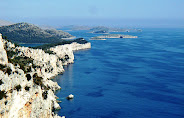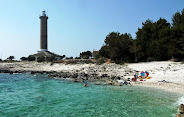Tourism, as a social-economic phenomenon developed as the political situation in the second half of 19th century calmed down after Napoleon wars and, also, due to modernization of traffic that made journeys specially long, railroad ones easier. Expending tourism and its mass character, makes rivieras, summer and winter resorts and specially spa and climate-health resorts well known. Istra was quite popular for clients from the very beginning of modern tourism because of mild and healthy climate and interesting history. After installing regular trip-liners Triest-Rijeka by Austrian Lloyd in 1844, ships regularly stopped in Piran, Novigrad, Poreč, Rovinj and Pula. With building of railroad Divača-Pula with an extension Kanfanar-Rovinj (1876), Rovinj tourism developed more, although those were only individual visits without organized groups. We take 1888 as the official beginning of tourism in Rovinj, when sea spa Mana Theresia Seehospiz for poor children with scrofula and rachitis was opened. Children came mostly from Austrian-Hungarian
mass character, makes rivieras, summer and winter resorts and specially spa and climate-health resorts well known. Istra was quite popular for clients from the very beginning of modern tourism because of mild and healthy climate and interesting history. After installing regular trip-liners Triest-Rijeka by Austrian Lloyd in 1844, ships regularly stopped in Piran, Novigrad, Poreč, Rovinj and Pula. With building of railroad Divača-Pula with an extension Kanfanar-Rovinj (1876), Rovinj tourism developed more, although those were only individual visits without organized groups. We take 1888 as the official beginning of tourism in Rovinj, when sea spa Mana Theresia Seehospiz for poor children with scrofula and rachitis was opened. Children came mostly from Austrian-Hungarian monarchy, but also from Germany, Russia and other countries. The first meteorological measurements of air temperatures began here and results were compared with those from Vienna. In 1890 four islands : St. Andrew, Maškin, Šturag and St. John were bought by knight Georg Hutterodt, an entrepreneur from Trieste. In following years he bought several private properties south of Rovinj in Punta Corrente, Montauro, Škarabe, Monvia and Monte Mulini. Almost 90 ha of meadow, vineyards and olive plantation were forested with carefully chosen Mediterranean and exotic plants creating a true natural park. The Old Town rises up on a peninsula and is a witness to times gone by and the valuable accomplishments of its past artisans. The limited space led to the construction of narrow buildings, streets and small town squares. Of particular interest in this town centre are the characteristically designed chimneys. The town itself was declared a cultural monument in 1963. By the seventh century AD, Rovinj was already surrounded by town walls, and later strengthened by the construction of towers. The old town had seven gates, while three still exist today: the Saint Benedict Gate, the Portico and the Holy Cross Gate.
monarchy, but also from Germany, Russia and other countries. The first meteorological measurements of air temperatures began here and results were compared with those from Vienna. In 1890 four islands : St. Andrew, Maškin, Šturag and St. John were bought by knight Georg Hutterodt, an entrepreneur from Trieste. In following years he bought several private properties south of Rovinj in Punta Corrente, Montauro, Škarabe, Monvia and Monte Mulini. Almost 90 ha of meadow, vineyards and olive plantation were forested with carefully chosen Mediterranean and exotic plants creating a true natural park. The Old Town rises up on a peninsula and is a witness to times gone by and the valuable accomplishments of its past artisans. The limited space led to the construction of narrow buildings, streets and small town squares. Of particular interest in this town centre are the characteristically designed chimneys. The town itself was declared a cultural monument in 1963. By the seventh century AD, Rovinj was already surrounded by town walls, and later strengthened by the construction of towers. The old town had seven gates, while three still exist today: the Saint Benedict Gate, the Portico and the Holy Cross Gate.  A baroque archway called "Balbijev luk", which today serves as the entrance into the old town, was built on the site of the former outer gate in the seventeenth century. The church of Saint Euphemia is a most imposing structure which bears the name of the patron saint of the town. It dominates the whole old town centre. It was built in the eighteenth century, while its façade in Venetian-baroque style was added in the middle of the last century. At the top of the sixty-metre-high bell tower stands the copper statue of St. Euphemia, which shows the direction of the wind by turning on a spindle. The baptismal font of the Holy Spirit has been constructed in a heptagonal shape and is the oldest relic situated in the Lokva Square. The thirteenth
A baroque archway called "Balbijev luk", which today serves as the entrance into the old town, was built on the site of the former outer gate in the seventeenth century. The church of Saint Euphemia is a most imposing structure which bears the name of the patron saint of the town. It dominates the whole old town centre. It was built in the eighteenth century, while its façade in Venetian-baroque style was added in the middle of the last century. At the top of the sixty-metre-high bell tower stands the copper statue of St. Euphemia, which shows the direction of the wind by turning on a spindle. The baptismal font of the Holy Spirit has been constructed in a heptagonal shape and is the oldest relic situated in the Lokva Square. The thirteenth  century Romanesque church which houses the font is also interesting because of the detailed carvings of the transenna depicting scenes of Golgotha. The Franciscan Monastery and church were built at the beginning of the eighteenth century. This interesting building built entirely in the Baroque style, contains a rich library and a fascinating museum of sacral artifacts. It is situated in De Amicis street. The castle on the island of St. Andrija was originally a Benedictine Monastery established in the sixth century AD. In the fifteenth century the Franciscan order added extensions and it was again refurbished at the end of the nineteenth century by Baron Hutterodt. The castle has now been converterd into a hotel.
century Romanesque church which houses the font is also interesting because of the detailed carvings of the transenna depicting scenes of Golgotha. The Franciscan Monastery and church were built at the beginning of the eighteenth century. This interesting building built entirely in the Baroque style, contains a rich library and a fascinating museum of sacral artifacts. It is situated in De Amicis street. The castle on the island of St. Andrija was originally a Benedictine Monastery established in the sixth century AD. In the fifteenth century the Franciscan order added extensions and it was again refurbished at the end of the nineteenth century by Baron Hutterodt. The castle has now been converterd into a hotel.
skip to main |
skip to sidebar

Peljesac

Peljesac

Dubrovnik

Paklenica


Dugi otok

Rogoznica

Susak

Peljesac

Primosten

Peljesac

Šibenik

Murter

Mljet


Rab

Pasman

Lastovo

Pag

Makarska

Makarska

Hvar

Komiza

Vis

Dugi otok

Hvar

Solta



Hvar

Korcula

Korcula

Hvar

Pag

Poreč

Pag

Kornati

Pag

Umag

Vis

Komiza

Rovinj

Pag

Krapanj

Bol
Have You ever been on Adriatic?
Weather in Croatia

Peljesac

Peljesac

Dubrovnik

Paklenica


Dugi otok

Rogoznica
Belvilla holiday homes – in Croatia:(click here to book online!)

Susak

Peljesac

Primosten

Peljesac

Šibenik

Murter

Mljet


Rab

Pasman

Lastovo

Pag

Makarska

Makarska

Hvar
Size: 180 X 150 pixels

Komiza

Vis

Dugi otok

Hvar

Solta



Hvar

Korcula
Size: 180 X 150 pixels

Korcula

Hvar

Pag

Poreč

Pag

Kornati

Pag

Umag

Vis

Komiza

Rovinj

Pag

Krapanj

Bol







